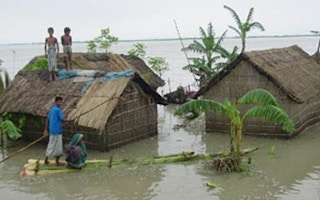In the district of Padmapukur, a few dozen kilometers from the Bay of Bengal, tin shacks balance delicately on scraps of land coming out of the sea, like makeshift boats lost in the middle of the ocean.
Only children, women, old people and the severly handicapped still live in the homes scattered along these dying rice paddies. In this region, which is subject to floods and cyclones, men have left to seek work elsewhere. There isn’t even enough wood to cook a loaf of bread. Traders on small boats laden with essential commodities come to supply the villagers.
In 2009, cyclone Aila killed a dozen people in the village. The inhabitants had to take refuge on the embankment, and waiting for months for the water to come down so they could rebuild their homes. In Padmapukur, they don’t even bother rebuilding brick houses. They make do with temporary walls made of corrugated iron.
Bangladesh is one of the countries most vulnerable to climate change. Two-thirds of the country is less than five meters above sea level. Rising water levels are already very noticeable in the islands along the Bay of Bengal, such as in Sagar or Kutubdia.
Bangladesh accounts for 60 per cent of the world’s cyclone victims in the past 20 years. According to the World Bank, up to eight million Bangladeshis may need to leave their homes by 2050.
For locals, the choice is simple: flee the south of the country or barricade themselves behind higher dikes. The Monwara family left its flood-ravaged village in 2007. They now live dozens of kilometers north of Padmapukur, in a small shack covered in branches, on a roadside. Raised a few meters, the roadsides here are very popular because they increase the chances of survival during flooding.
Click here to read the full story.










